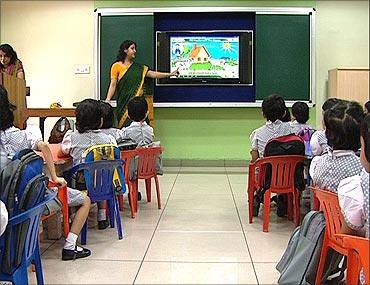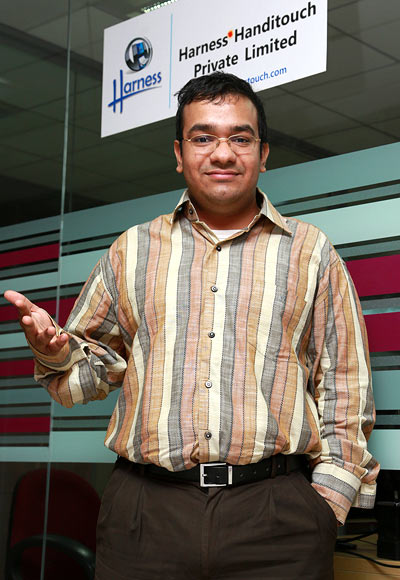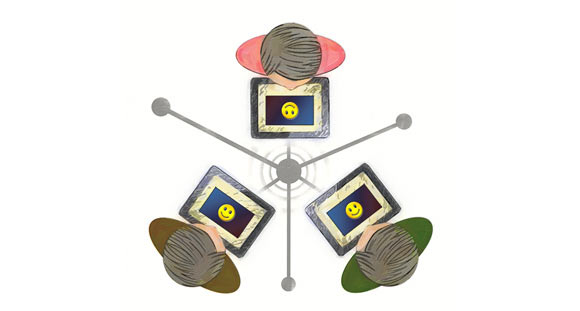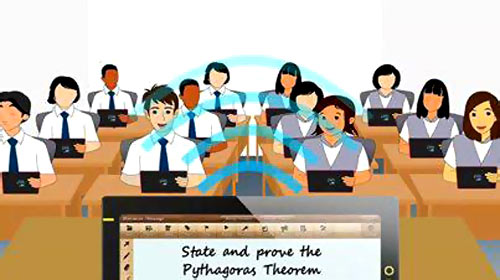Photographs: Rediff Archives Shobha Warrier
An engineer from IIT Madras V Subramanian's dream is to introduce technology-enabled teaching into classrooms. Read on to know more about the inspiration behind his entrepreneurial journey.
V Subramanian created his first start-up soon after he passed out of the Indian Institute of Technology Madras in 2004.
It was an instant success and he made a million dollars by selling it to the ICICI Bank.
He then went to study business at the Indian School of Business in Hyderabad.
After gaining some experience in the corporate world, he founded his next venture Harness Handitouch Pvt Ltd that aims to revolutionise the education space, along with his classmate at ISB, Kuljit Chaddha.
It was one of the 11 start-ups chosen by Microsoft for the Microsoft Accelerator for Windows Azure (India) in India.
Here, the 30-year-old founder and CEO of the company talks about his journey as an entrepreneur.
An entrepreneur is born
I had this desire to be an entrepreneur while I was studying at IIT Madras.
I liked the idea of creating things. Maybe seeing my industrialist father run a manufacturing company with a team of 300 people inspired me.
I felt entrepreneurship was more rewarding and attractive than working for somebody else. Other than making commercial gains, you help so many families and give opportunities to many.
After I graduated from IIT Madras in 2004, I started my first start-up with my industrialist father.
Though I secured admission at Stanford (University), I decided to stay back in India and be an entrepreneur.
I would say I started it with my father's capital. The software company developed ERP software for manufacturing companies.
I love the experience of building things.
In 2007, it was acquired by the ICICI Bank for under a million dollars.
Please click NEXT to continue reading...
'My one year at ISB changed my view on how to run a company'
Image: V SubramanianPhotographs: Sreeram Selvaraj
The ISB experience
Once my first start-up got acquired, I decided to join the Indian School of Business and study MBA.
ISB trains one to be a leader in business and also takes pride in producing entrepreneurs.
I feel any business school is a great experience for an entrepreneur.
My one year at ISB did change my view on how to run a company.
You try to be very ambitious after an MBA. You will not think small.
You realise that you can't go purely by passion; you do a lot of market research.
When I started my first start-up, it was purely based on passion and nothing else.
Professional training
I decided to work in a corporate atmosphere for a few yeas and gain some experience in running a company professionally.
I am of the strong opinion that if you get some corporate experience, it will help you in your venture and also make you well rounded.
In my case, McKinsey exposed me to many ways of strategic thinking. Their people-processes are also phenomenal.
Days with such an institution helps you apply all that you learn in your enterprise too. It helps you be a people-leader.
Idea germinates at McKinsey
While working at McKinsey, I was all the time thinking of my own start-up.
I wanted to build a great company and build products.
Once after a presentation, we saw someone using a touchpad to take notes and doing all the interactions on it. That was what gave me the spark.
I felt classrooms and meetings should be run like that, with a networked touchpad.
There had to be a collaboration between the participants and the presenters.
I wondered why not take the idea to a classroom; to every student.
That was the time tablets had not taken off. The idea was, why not change the physical paper with tablets? I felt the classroom was the place where such collaboration was needed.
'Students can also do combined study remotely, sitting at home'
Image: An illustration of students using technology to interact with each otherPhotographs: Courtesy Harness Handitouch
I formulated the idea in 2010 while I was with McKinsey.
The moment I got the idea, I picked up the phone and called my friend from ISB, Kuljit Chaddha, and the first thing he told me was, you sold your first start-up for $ 1 million and you will sell this for $10 million! He said he was in.
If my strength is product conception, his strength is sales and marketing and business planning.
Both of us presented the idea to an angel investor and luckily, he liked our idea.
He agreed to sign an amount of Rs 1 crore.
I was not expecting an angel investor to invest when the idea was still on paper. I was lucky, I would say.
McKinsey was also happy that I got an investor.
In January 2011, we incorporated the company, Harness Handitouch Pvt. Ltd with a capital of Rs 1.2 crores.
In July 2011, I came back from London where I was at that time.
With four people with us as product developers, we started functioning.
The first product
It took us about nine months to build a product that can work in a classroom. Today, we have a version 4 and we are constantly improving the product.
The idea is to produce technology enabled pedagogy in the classroom. We use tablets, networking and cloud computing to achieve this.
If a class has 40 students, all the tablets are networked to the teacher and among themselves.
Whatever the teacher writes on the board will be there on the screens of all students.
Instead of copying what the teacher writes on the board, here the students can write their own interpretation of what the teacher writes.
Without going to each student and seeing what he has written, the teacher can do that by looking at his/her tablet and check it live. She can show it to other students too.
At the IIT, a lot of my learning came from interactions with my classmates. Similarly, school students can also do combined study remotely, sitting at home as their tablets are networked.
Tablets come to classrooms
As we use tablets with touch screen and it can be used for remote learning, we named it Touch on cloud. It is aimed at the schools and colleges in India.
We targeted international schools first as only those students can afford tablets in the class.
We piloted with over 1000 students in consultation with a few teachers.
Our first pilot was in March 2012 and the first sale was in December 2012 to a Mumbai school and another school in Aurangabad.
We start with classes 6, 7 or 8 as the students are old enough to hold a tablet and young enough to experiment.
'We want to sign up a million students in the next three years'
Image: An illustration of students using Harness' technology in a classroomPhotographs: Courtesy Harness Handitouch
We have seven live clients in India which include colleges too.
We have closed deals in the Middle East in Qatar and Bahrain.
In Spain, we are closing a very huge deal.
This year, our concentration will be on the India, Spain and the Middle East market.
We are also aggressively looking at the US market and have developed a new product, Unio which is our new app store version for the US market.
The style of selling and the behaviour of the market is also different there.
And the US is a very huge market with more than 55 million students there.
We want to sign up a million students in the next three years. That will be $10 million business for us.
Our model is annual subscription, and so it is a recurring revenue.
The Microsoft advantage
We were one of the 11 start-ups chosen by Microsoft to incubate.
They not only incubate but provide technical support, office space, access to angel investors and market support.
We wanted to move from B2B to B2C. We wanted to introduce Unio that can be downloaded from our app store.
With their help and expertise, our product has come a long way.
They also give access to mentors who will sit on your advisory board. The help has been fabulous.
Plans for future
Our focus is going to be the international market, the Middle East, Spain and the US. We want to hit a million dollars this year but we may end up with just $800,000.





Comment
article